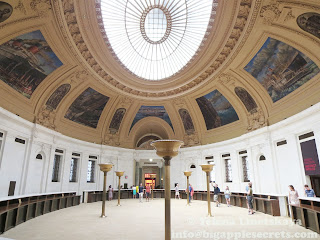 Battery Park is a packet of open space in crowded Lower Manhattan. In 1623 Dutch settlers landed here and later established New Amsterdam. The twenty-five acre park has long been a favorite destination for tourists and nearby office workers. It offers a tang of salt breeze and views of passing vessels and the Statue of Liberty. This park is a home to Castle Clinton and a World Trade Center Sphere.
Battery Park is a packet of open space in crowded Lower Manhattan. In 1623 Dutch settlers landed here and later established New Amsterdam. The twenty-five acre park has long been a favorite destination for tourists and nearby office workers. It offers a tang of salt breeze and views of passing vessels and the Statue of Liberty. This park is a home to Castle Clinton and a World Trade Center Sphere.
New York was severely affected by Hurricane Sandy in 2012- the damage to the park was complex and costly. Now almost all park of the park are restored. There is even a new addition - a SeaGlass Carousel, that opened in the second part of August this year. New Yorkers and tourists can take a ride and see city views from a new perspective. Instead of a single turntable that moves in one direction, there are three turntables that spin inside a larger disc in this carousel.
SeaGlass has 18 axes of movement, compared with just two in a traditional carousel. "It could feel like you're floating up or dropping down, or moving with a group that's right beside you, so it feels like a school of fish," said the constructor of the SeaGlass, Weisz Claire. Weisz is an architect and a founding principal of WXY. There are 30 iridescent glass sea creatures inside the carousel, that cost $16 million to build. Half of this money, $8 million, was paid for by the city. The ride is scored by adaptations of classics: Mozart's 40th Symphony and Prokofiev's "Dance of the Knights" from Romeo and Juliette.

Rides on the Seaglass Carousel cost $5 and last about three and a half minutes.
It took 10 years to build the carousel. In 2007 Curbed wrote: The Battery Park "Sea Life" Carousel, which would be made of "smart glass" that goes from transparent to dark blue with images of fish projected on it, is still chugging along. into it. The Battery Conservancy is trying to raise public money to cover $6 million in construction costs, about $1.65 million of which has been raised. There's also a need for $5 million in private money for maintenance, with $2.4 million raised. The other part of the plan is a ferry from the Battery to Coney Island and the Rockaways.
Frankly speaking, I think that New York city does not such a pricy project - I prefer to have a ferry. But nobody asked my opinion - the carousel was built and the project about the ferry from Coney Island to Battery Park was forgotten.



















































